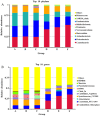Comparative analysis of bacterial communities and environmental interactions in seawater and saline-alkali aquaculture ponds for Scylla paramamosain in northern China
- PMID: 40469721
- PMCID: PMC12133951
- DOI: 10.3389/fmicb.2025.1589304
Comparative analysis of bacterial communities and environmental interactions in seawater and saline-alkali aquaculture ponds for Scylla paramamosain in northern China
Abstract
As the aquaculture capacity of S. paramamosain in southern China nears saturation, northern coastal regions, which are characterized by abundant water resources, ample feed availability, and favorable climatic conditions, have emerged as ideal areas for aquaculture expansion. This study investigates the aquatic environment of S. paramamosain cultured in seawater and saline-alkali ponds in northern China. Over the course of a five-month aquaculture experiment, water samples were collected from seawater and saline-alkali ponds and subsequently analyzed using 16S rRNA gene sequencing technology to examine the bacterial community composition and its relationship with physicochemical water quality parameters. Sensitive bacterial species were identified as well. The results revealed that seawater ponds exhibited higher salinity and dissolved oxygen levels, but lower pH, ammonia nitrogen, and nitrite nitrogen concentrations. In contrast, saline-alkali ponds exhibited elevated pH, ammonia nitrogen, and nitrite nitrogen levels, accompanied by reduced salinity and dissolved oxygen. Bacterial communities in seawater ponds demonstrated greater species richness, evenness, and diversity indices, whereas those in saline-alkali ponds were characterized by reduced diversity and distinct dominant bacterial groups. Redundancy analysis (RDA) identified salinity, pH, and dissolved oxygen as the principal environmental factors influencing bacterial community structure. Using the IndVal method, we identified strong associations between specific bacterial species and pond types, such as Sphingoaurantiacus and Cobetia in seawater ponds, and Roseivivax, Tropicimonas, and Thiobacillus in saline-alkali ponds. Environmental factors exerted distinct effects on bacterial communities in the two pond types, with sensitive bacterial species demonstrating significant specificity and strong correlations with water quality parameters. Functional predictions indicated that microbes in saline-alkali ponds prioritized resource acquisition and stress resistance, whereas those in seawater ponds emphasized nitrogen metabolism and protein synthesis. This study demonstrated significant differences in bacterial community characteristics between seawater and saline-alkali ponds, which were strongly influenced by water quality parameters. These findings are crucial for optimizing the growth environment of S. paramamosain, providing essential data for improving aquaculture conditions and promoting the development of northern S. paramamosain farming.
Keywords: 16S rRNA gene sequencing; Scylla paramamosain; aquaculture; bacterial communities; saline-alkali water pond; seawater pond.
Copyright © 2025 Zhou, Fu, Liu, Lin, Lu, Ye and Zhang.
Conflict of interest statement
The authors declare that the research was conducted in the absence of any commercial or financial relationships that could be construed as a potential conflict of interest.
Figures






References
-
- Aboul-Maaty N. A. F., Oraby H. A. S. (2019). Extraction of high-quality genomic DNA from different plant orders applying a modified CTAB-based method. Bull. Natl. Res. Cent. 43, 1–10. doi: 10.1186/s42269-019-0066-1 - DOI
-
- Ahmad L., Shah G. M. S., Biswas A. (2024). Fundamentals and applications of crop and climate science. Cham, Switzerland: Springer.
-
- Ahmed A., Khurshid A., Tang X., Wang J., Khan T. U., Mao Y. (2021). Structural and functional impacts of microbiota on pyropia yezoensis and surrounding seawater in cultivation farms along coastal areas of the yellow sea. Microorganisms 9:1291. doi: 10.3390/microorganisms9061291 - DOI - PMC - PubMed
-
- Alvarado-López M. J., Garrido-Hoyos S. E., Raynal-Gutiérrez M. E., El-Kassis E. G., Luque-Almagro V. M., Rosano-Ortega G. (2023). Cyanide biodegradation by a native bacterial consortium and its potential for goldmine tailing biotreatment. Water 15:1595. doi: 10.3390/w15081595 - DOI
LinkOut - more resources
Full Text Sources
Research Materials

